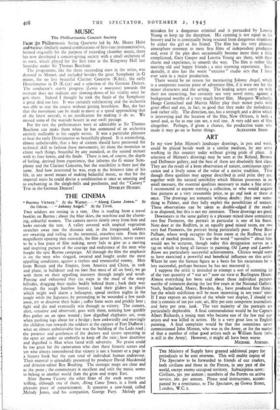ART
IN my view John Minton's landscape drawings, in pen and wash, could be placed beside work in a similar medium, by any artist working in this country today without giving pride of place. A selection of Minton's drawings may be seen at the Roland, Browse and Delbanco gallery, and the best of them are absolutely first class. They are the result of a keen observation of nature, continuous appli- cation and a lively sense of the value of a native tradition. Trite though these qualities may appear described in cold print they are, together with the natural sensibility which Minton possesses in no small measure, the essential qualities necessary to make a fine artist. I recommend to anyone starting a collection, or who would acquire fine pictures at a very reasonable price, to go and look at these at once. The drawings are romantic without doubt : they owe some- thing to Palmer, and they fully exploit the possibilities of texture. These observations can be taken as double-edged if the reader is so disposed, but this is not my intention. These drawings are good.
Downstairs in the same gallery is a pleasant mixed show containing two fine Pasmores, the portrait in particular is one of his finest. Next door at the Redfern, in an equally good mixed room, are two very bad Pasmores, the portrait being particularly poor. Peter Rose Pulliam, whose woric occupies the front room at the Redfern, is an artist of morbid promise. To use the word " surrealist " about him would not be accurate, though today this designation serves as a tag on which to hang all fantasy in painting. Oil Lamp and Lumber Room are particularly successful achievements. Chirico would seem to have exercised a powerful and beneficial influence on this artist. Where he uses the human figure as a basis for his excursions he is less successful, perhaps because he has not mastered it.
I suppose the critic is intended to attempt a sort of summing up of the vast quantity of " war art " now on view at Burlington House. Almost everything has been said about those individual pictures worthy of comment during the last five years at the National Gallery. Nash, Sutherland, Moore, Bawden, &c., have produced fine things, but the whole exhibition will be more interesting in ten years' time. If I may express an opinion of the whole vast display, I should say that it consists of ten per cent. art, fifty per cent competent journalism, and forty per cent. junk. The vast majority of the portraits are particularly deplorable. A final commendation would be for Captain Albert Richards, a young man who became one of the few real war artists and was killed in action. He is a very great loss to English painting. A final complaint would be that the committee never commissioned John Minton, who was in the Army, or for the matter of that a number of other good artists such as William Scott (who is still in the Army). However, it might all have been worse.
MICHAEL AYRTON.






























 Previous page
Previous page